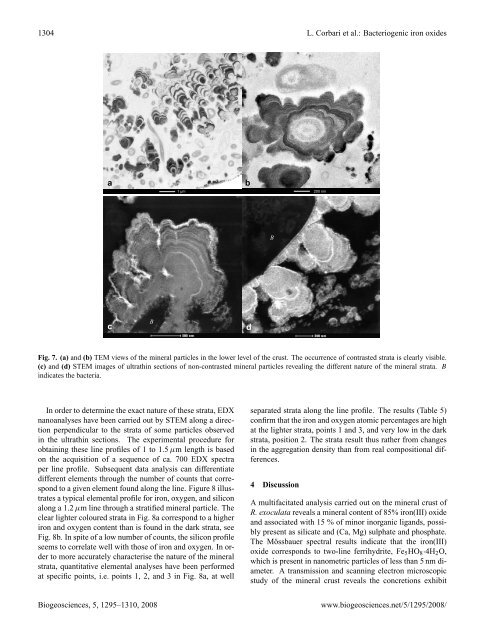View - Biogeosciences
View - Biogeosciences
View - Biogeosciences
Create successful ePaper yourself
Turn your PDF publications into a flip-book with our unique Google optimized e-Paper software.
g-2008-0022<br />
Corbari et al., Figure7<br />
1304 L. Corbari et al.: Bacteriogenic iron oxides<br />
a<br />
1 µm<br />
b<br />
200 nm<br />
B<br />
c<br />
B<br />
d<br />
Fig. 7. (a) and (b) TEM views of the mineral particles in the lower level of the crust. The occurrence of contrasted strata is clearly visible.<br />
(c) and (d) STEM images of ultrathin sections of non-contrasted mineral particles revealing the different nature of the mineral strata. B<br />
indicates the bacteria.<br />
In order to determine the exact nature of these strata, EDX<br />
nanoanalyses have been carried out by STEM along a direction<br />
perpendicular to the strata of some particles observed<br />
in the ultrathin sections. The experimental procedure for<br />
obtaining these line profiles of 1 to 1.5 µm length is based<br />
on the acquisition of a sequence of ca. 700 EDX spectra<br />
per line profile. Subsequent data analysis can differentiate<br />
different elements through the number of counts that correspond<br />
to a given element found along the line. Figure 8 illustrates<br />
a typical elemental profile for iron, oxygen, and silicon<br />
along a 1.2 µm line through a stratified mineral particle. The<br />
clear lighter coloured strata in Fig. 8a correspond to a higher<br />
iron and oxygen content than is found in the dark strata, see<br />
Fig. 8b. In spite of a low number of counts, the silicon profile<br />
seems to correlate well with those of iron and oxygen. In order<br />
to more accurately characterise the nature of the mineral<br />
strata, quantitative elemental analyses have been performed<br />
at specific points, i.e. points 1, 2, and 3 in Fig. 8a, at well<br />
separated strata along the line profile. The results (Table 5)<br />
confirm that the iron and oxygen atomic percentages are high<br />
at the lighter strata, points 1 and 3, and very low in the dark<br />
strata, position 2. The strata result thus rather from changes<br />
in the aggregation density than from real compositional differences.<br />
4 Discussion<br />
A multifacitated analysis carried out on the mineral crust of<br />
R. exoculata reveals a mineral content of 85% iron(III) oxide<br />
and associated with 15 % of minor inorganic ligands, possibly<br />
present as silicate and (Ca, Mg) sulphate and phosphate.<br />
The Mössbauer spectral results indicate that the iron(III)<br />
oxide corresponds to two-line ferrihydrite, Fe 5 HO 8·4H 2 O,<br />
which is present in nanometric particles of less than 5 nm diameter.<br />
A transmission and scanning electron microscopic<br />
study of the mineral crust reveals the concretions exhibit<br />
<strong>Biogeosciences</strong>, 5, 1295–1310, 2008<br />
www.biogeosciences.net/5/1295/2008/
















